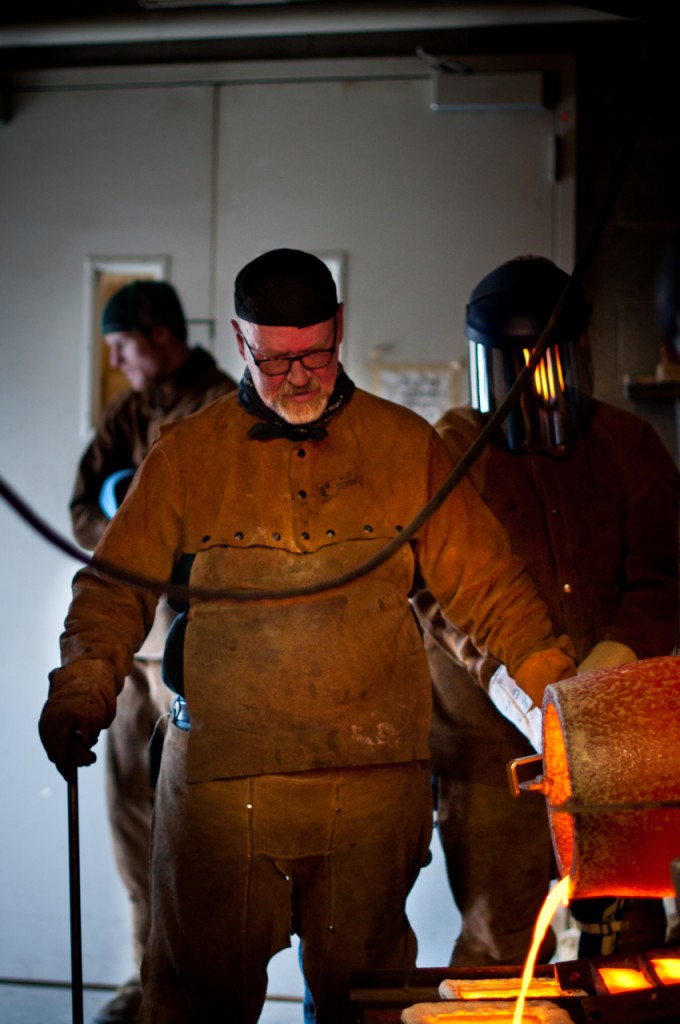Personal Navigational Device

Doug Kaigler’s mixed media sculpture Personal Navigational Device, presently installed at EOU’s Nightingale Gallery, evokes more visually and emotionally than any typical gyroscope. At first glance, it appears relatively simple: the center of the gyroscope, made of glass and filled with translucent green water, holds a single oval rock. Observing the physical connections of the various metal disks, one realizes that this work is moveable and functional with a direct light shining upon it, through the water, creating another layer to the piece against the cold gallery floor -- two beautiful, glowing green reflections encompassed by the piece’s shadows. The main base cradling the liquid and rock includes four flat bronze points with the largest protrusion of the rock leaning directly, as if pointing, toward one of the points. 
Gyroscopes have multiple purposes today, more than just compasses. They are now added in many smartphones as part of the GPS system and a few years ago Nintendo released the Wii MotionPlus, an addition to the Wii remote, to more accurately assess the gamer’s physical actions. They help us get to where we need to be, balance a cruise ship so the pool tables are level, and even more than that, gyroscopes give us direction.
After taking a moment to reflect on the purpose of the gyroscope, the question arises why would Doug create this work of bronze, steel, water, glass, and rock? Why didn’t he just weld the circular disks? Why make it functional and movable, especially since, according to one of the gallery students, the gyroscope is incredibly fragile as it moves? This four-foot tall compass stands alone in the gallery’s corner, but its sense of eternal motion brings the viewer around it again as if it spins on its own like the globe we’re standing on while the angle of one of the gyroscope discs’ is reminiscent of the tilt of the earth’s axis. Doug’s compass, though emitting a coldness from a metal, brings also warmth from the water. The fragility of the glass reminds us of the imperfection and easily changeable nature of our planet. Glass, something we use daily either in our mirrors, on our cars, for our homes, comes from simple ingredients such as sand, oyster shells, pebbles, quartz -- to name a few since it varies so drastically from culture to culture between 3500 BCE to today. Combining items such as these and melting them creates a unique range of glass varieties.The gyroscope, when compared the the earth, brings the idea that the rock could be our substance, our foundation against the fragility of our lives. The rock also holds a sense of belonging and vitality within the space of the green waters. But what of the reflections? The two glowing circles of light are not identical. The main light source above creates the first reflection, which is nearly oval and very bright. The way the light casts it is like the sun against our frame and the green is our hidden soul, the essence of the water narrowed down to a simple direction of light. The second reflection is created by a second, further light source, causing an arrow-like point on the side facing away from the gyroscope. This pieces evokes direction not only in its strictest definition, but the way Doug structured it. He is showing us our past in the main reflection, very clear and vibrant and set in stone pointing us to our future -- unclear and unsure -- in the arrow reflection. The rock emerging from the green waters grounds us in the piece as the metal discs float in orbit.
In Doug’s Personal Navigational Device, the rock belongs within the sphere, just as we belong on our sphere, bathed in light longing to move forward and find our place among the rest of humanity and the rest of the universe.
**Doug Kaigler doesn't have an official website that I know of. So, I've compiled a handful of various images of his work. I don't know all of the titles **
**For more information on Doug Kaigler, see the following websites:
-EOU Faculty Page
-Teaching Multiwriting: Researching and Composing With Multiple Genres, Media ...
By Robert L. Davis, Mark F. Shadle-Eugene Weekly Article








No comments:
Post a Comment